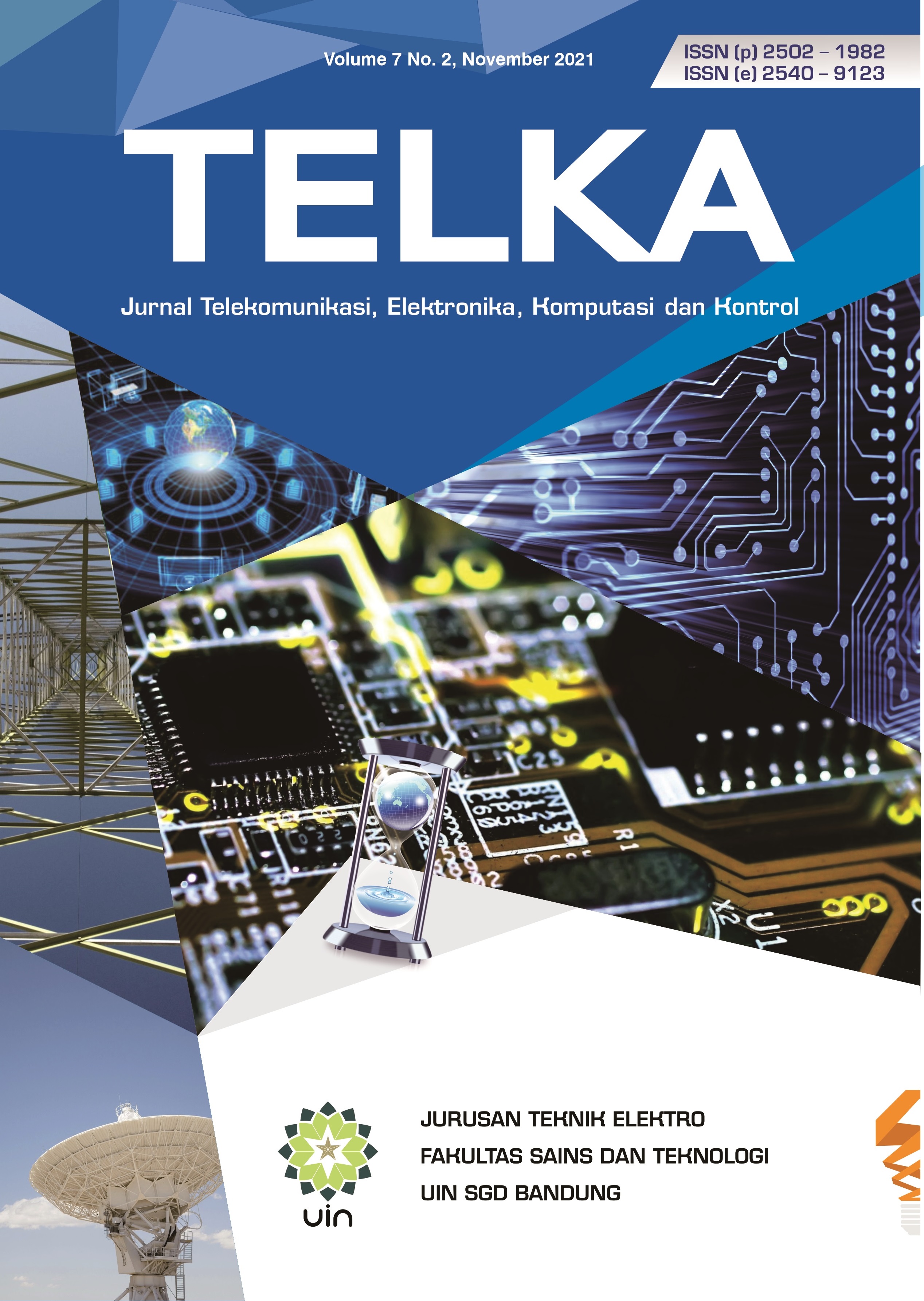Smart Helmet First Person View (Set-fpv) sebagai Perangkat Teknologi Pembelajaran Tatap Muka Virtual Semi Realistik pada Kelas Praktikum Elektropneumatik Jarak Jauh
DOI:
https://doi.org/10.15575/telka.v7n2.108-119Kata Kunci:
Smart helmet first person view, IoT, IP Cam, praktikum jarak jauh, face-to-face, semi-realisticAbstrak
Adanya pandemi Covid-19 membuat dibatasinya aktivitas pembelajaran dalam bentuk pertemuan fisik. Kondisi tersebut mempengaruhi pembelajaran pada sekolah vokasi, termasuk politeknik, yang aktivitas praktiknya memerlukan pertemuan tatap muka. Agar kegiatan praktik dapat tetap dilaksanakan dengan baik, perlu dikembangkan metode praktikum jarak jauh yang memanfaatkan teknologi. Penelitian ini mengembangkan alat yang memadukan teknologi Internet of Things dan kamera berbasis Internet Protocol yang disebut Smart Helmet First Person View (Set-fpv). Perangkat Set-fpv yang digunakan dalam penelitian ini terdiri dari sebuah helm yang dimodifikasi dengan IP cam nirkabel, dan headphone Bluetooth yang tersambung ke Smartphone atau komputer praktikum. Penelitian dilakukan selama satu semester di Politeknik Kota Malang, Program Studi Teknik Mekatronika. Responden penelitian sebanyak 29 mahasiswa konsentrasi Otomasi Industri, dan 24 mahasiswa Konsentrasi Alat Berat yang mengikuti mata kuliah Elektro Pneumatik. Sebelum dan sesudah mengikuti praktik seluruh responden diberikan soal pretest dan posttest secara daring, kemudian hasil test antara kelompok kontrol yang menggunakan perangkat lunak simulasi FluidSim dengan kelompok eksperimen yang menggunakan Set-fpv diperbandingkan nilai reratanya. Penggunaan bandwidth tertinggi pada perangkat Set-fpv sebesar 102,43 Mbps untuk melakukan streaming selama satu semester dengan resolusi 1080p terhadap delapan perangkat. Validasi perangkat dilakukan oleh ahli teknologi dengan indikator tujuh poin. Berdasarkan penilaian ahli teknologi nilai rerata penerimaan produk sebesar 88,5 persen yang tergolong baik, sedangkan hasil penilaian ahli materi dan ahli media sebesar 82,6 persen dengan penerimaan tergolong baik. Hasil penelitian menunjukan terjadi kenaikan nilai posttest dari pretest yaitu dengan peningakatan sebesar 9,59% dengan nilai rerata sebesar 8,1 terhadap kelompok eksperimen, sedangkan pada kelompok kontrol sebesar 7,9.
The Covid-19 pandemic has restricted learning activities in the form of physical meetings. These conditions affect learning experience in vocational schools, including polytechnics. In order for the practical course to be carried out properly, it is necessary to develop a remote practical course method that utilizes technology. This research develops a tool that combines Internet of Things technology and Internet Protocol-based camera called Set-fpv (Smart Helmet First Person View). The Set-fpv device used in this study consisted of a modified helmet with a wireless IP cam, and Bluetooth headphones connected to a Smartphone or a computer. The research was conducted for one semester at the Politeknik Kota Malang, Mechatronic Engineering Program. The research respondents were 29 students of Industrial Automation concentration, and 24 students of Heavy Equipment Concentration who took the Electrical Pneumatics course. Before and after participating in the practical course, all respondents were given online pretest and posttest questions, the test results between the control group using the FluidSim simulation software and the experimental group using Set-fpv were compared with the mean values. The highest bandwidth usage on Set-fpv devices is 102.43 Mbps to stream for one semester with 1080p resolution on eight devices. Device validation is carried out by experts based on seven-point indicators. The results shows that (1) the validation results from tech experts, materials experts, and media experts with seven indicator points, reached 88.5% of validity by tech experts meaning a good acceptance conclusions and 82.6% by material and media experts meaning a good acceptance conclusions. (2) The highest total internet bandwidth usage (while using 1080p streaming) and 8 IoT smart switch devices is 102.43 Mbyte for 1 semester, and (3) Grades that are taken from a homogeneous student groups shows an increased in their practical performances. The results showed an increase of 9.59% with the the pretest value of 8.1 to the experimental group, while in the control group it was 7.9.
Referensi
“Coronavirus disease (COVID19),” who, [Online]. Available: https://www.who.int/emergencies/diseases/novel-coronavirus-2019. [Diakses 9 Maret 2021].
J. Chan, S. Yuan, K. Kok, K. To, H. Chu dan J. Yang, “A familial cluster of pneumonia associated with the 2019 novel coronavirus indicating person-to-person transmission: a study of a family cluster,” Lancet, vol. 295, pp. 14-23, 2020.
I. Ghinai, T. McPherson, J. Hunter, H. Kirking, D. Christiansen dan K. Joshi, “First known person-to-person transmission of severe acute respiratory syndrome coronavirus 2 (SARS-CoV-2) in the USA,” Lancet, vol. 395, pp. 1137-1144, 2020.
C. Huang, Y. Wang, X. Li, L. Ren, J. Zhao dan ,. Hu, “Clinical features of patients infected with 2019 novel coronavirus in Wuhan,” Lancet, vol. 395, pp. 497-506, 2020.
J. Liu, X. Liao, S. Qian, J. Yuan, Wang.F dan Y. Liu, “Community Transmission of Severe Acute Respiratory Syndrome Coronavirus 2,” Emerg Infect Dis, vol. 26, no. 3, p. 1320, 2020.
R. Pung, C. Chiew, B. Young, S. Chin, M. Chen dan H. Clapham, “Investigation of three clusters of COVID-19 in Singapore: implications for surveillance and response measures,” Lancet, vol. 395, pp. 1039-1046, 2020.
L. Luo, D. Liu, X. Liao, W. X, Q. Jing dan J. Zheng, “Modes of contact and risk of transmission in COVID-19 among close contacts,” MedRxiv, 2020.
“Peraturan Walikota Malang no 30 Tahun 2020,” Hukumonline, [Online]. Available: https://covid19.hukumonline.com/wp-content/uploads/2020/09/peraturan_wali_kota_malang_nomor_30_tahun_2020.pdf. [Diakses 9 Maret 2021].
Dubey, Pushkar dan P. Deepak, “Distance learning in higher education during pandemic: challenges and opportunities,” Int. J. Ind. Psychol, vol. 8, no. 2, pp. 43-46, 2020.
T. e. a. Eldemerdash, “IoT Based Smart Helmet for Mining Industry Application,” International Journal Advance Science Technology, vol. 29, pp. 373-387, 2020.
J. Mingi, “Development and application of the smart helmet for disaster and safety,” dalam International Conference on Information and Communication Technology Convergence (ICTC), Jeju Island, 2018.
P. a. D. S. Roja, “Iot based smart helmet for air quality used for the mining industry,” Int. J. Res. Sci. Eng. Technol, vol. 4, pp. 514-521, 2018.
Sanjay dan S. Bhagat, “Smart helmet using zigbee,” Int. J. Innov. Res. Technol, vol. 6, pp. 144-148, 2019.
M. Mohammed, “Novel COVID-19 detection and diagnosis system using IOT based smart helmet,” International Journal of Psychosocial Rehabilitation, vol. 7, no. 24, pp. 2296-2303, 2020.
Sugiyono, Metode Penelitian Kuantitatif Kualitatif dan R&D, Bandung: Alfabeta, 2011.
“Electropneumatics Workbook,” Festo, 2016. [Online]. Available: https://www.festo-didactic.com/ov3/media/customers/1100/541090_v2.1_leseprobe_en.pdf. [Diakses 9 Mei 2021].
P. Waher, P. Seneviratne, B. Russell dan D. Duren, IoT, Packt Publishing, 2016.
“Introduction: Blynk Documentation,” Blynk, 2021. [Online]. Available: https://docs.blynk.io/en/. [Diakses 9 Mei 2021].













